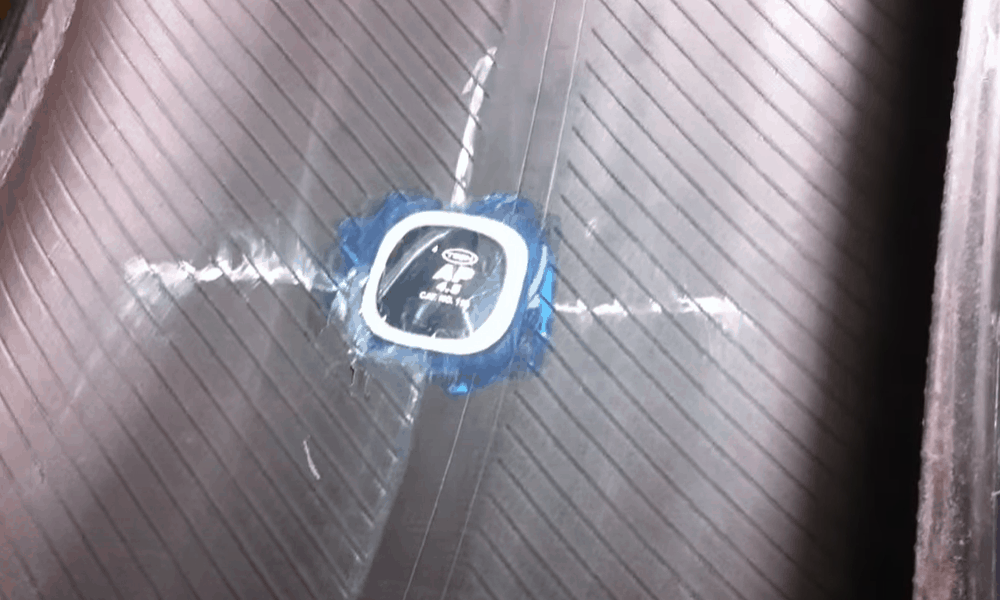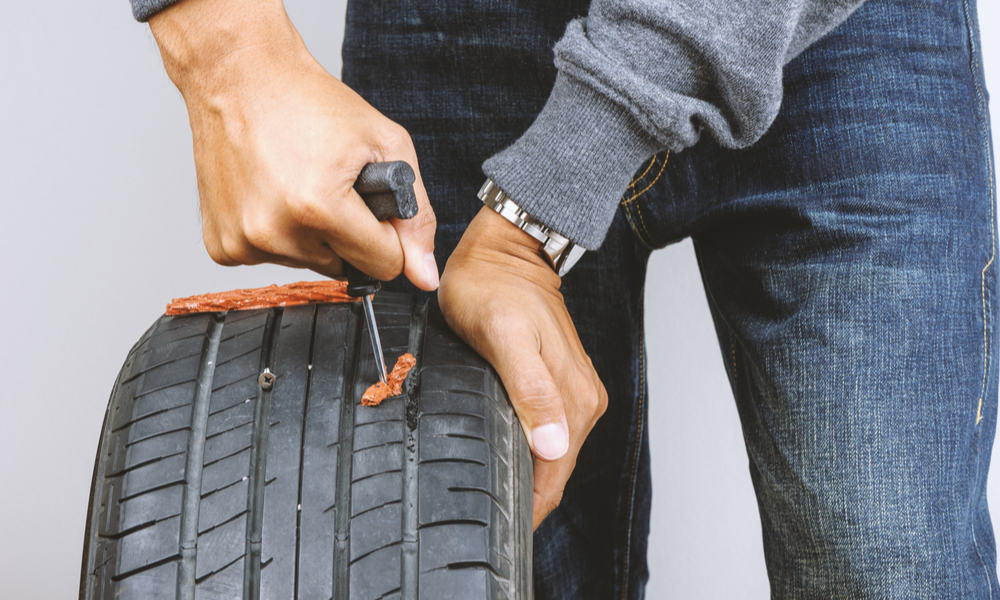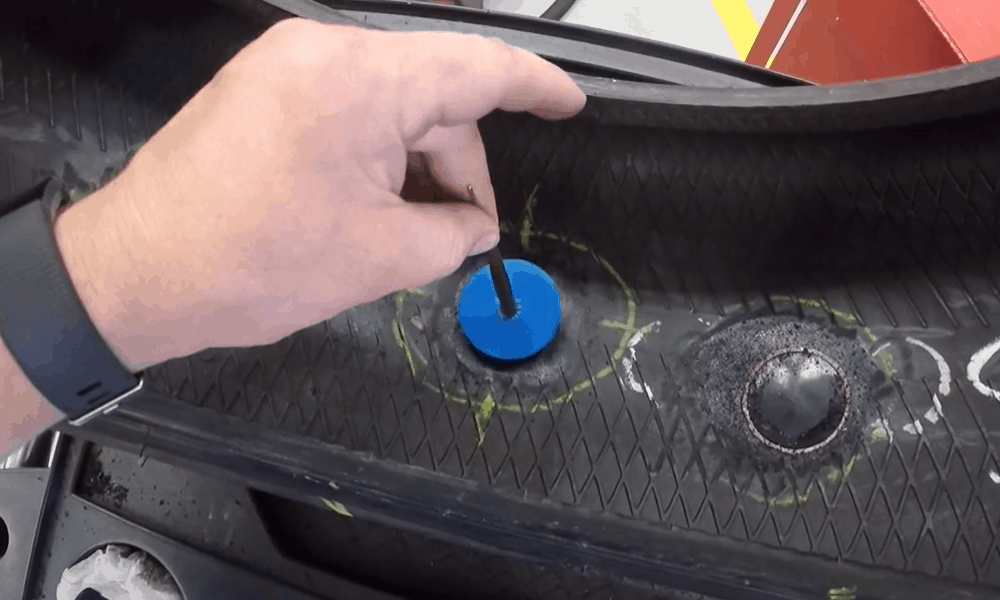Your car’s tires are the critical component that connects your car with the surface of the road you’re traveling. When you have a flat tire emergency, what is the solution for fixing it?
No matter when you have a flat tire, it will be one of the most inconvenient things that can happen while you’re driving. And, unfortunately, it always results in you losing time to fix the problem.
Your tire will lose air because of several reasons. Usually, you have run over an object in the road that caused a puncture and the air began to slowly leak out. Another major reason is driving with too low much or too low pressure.
The damage may not even be noticeable from outside the tire. Here’s a prime example of when a tire is run without enough pressure.
There are 3 common methods for repairing a punctured tire:
- Patch-only,
- A tire plug, or
- A combination of the two
Both the patch-only and the combination repairs require a technician to dismount the tire and look at the inside wall to see if there is any damage. As long as there is no damage to the sidewall, a repair can be made.
Plug-Only repairs, however, are much easier and can be done from the outside of the tire with no need for the tire to be dismounted.
Patch Only Repair

When tire rubber is punctured, the accepted procedure is to find the rupture and swab around it with a soapy solution of water, or he may hold it inside a tank of water and look for escaping bubbles of air.
The area is then prepared with a scraper or buffing tool and cleaning solution to make it suitable for bonding with the repair patch.
A vulcanizing cement is then applied under the patch and over the inner liner of the tire and the patch is applied over the puncture. The surrounding area is then stitched or rolled and covered with sealant before the tire is mounted back on the rim.
Once a tire is properly patched, you should be able to drive safely for a fairly long time. However, even though a patch is usually stronger than a plug, it will not work on or near to a sidewall.
The tire industry, however, warns against the patch only repair method. Air and moisture can seep into the tire from the outside tread and enter from around the edges of the patch.
Plug-Only Repair

Plug-only repair is much simpler. The technician finds the puncturing object and removes it. An insertion tool with a plug is inserted into the rupture from outside the tire. After it is removed, the plug remains inside the rupture.
Often, this type of repair will use a “string plug” consisting of a short woven cord covered with tacky sealant. String plugs will often be included with automobile repair kits. Both reaming and insertion tools are also included along with an assortment of string plugs.
Occasionally a kit can also contain a tube of rubber cement to add additional sealant to the string plug. These kits can be an alternative for drivers who want to save a little money or for emergencies when it’s not possible to dismount the tire and properly apply a patch.
However, even though tires repaired this way will continue to hold air for a few months, tire manufacturers also warn against its use. A string plug type of repair can allow moisture and air to enter the tire and get between the tire layers.
The steel in the belts can then degrade over time and the tire can corrode and deteriorate. With the belts and the bond between the rubber layers weakened, there is a greater risk the tread will separate while driving.
Another risk of a string plug type of tire repair is that even when a puncture is repaired, there can be additional damage to the tire that is not apparent. The tire must be removed and visually examined to be sure there is no unusual internal damage.
Combination Repair

The National Highway Traffic Safety Administration advises that the proper method to repair a tire puncture is to use a combination repair. (Download the NHTSA guidelines here.) A combination repair, as the name implies, involves using a tire repair patch and a rubber plug (stem) attached to its center.
After finding the puncture, it should be reamed out so that a clean hole remains for insertion of the plug. The inside area surrounding the puncture should be then prepared for bonding with the patch with a vulcanizing cement.
Apply the cement to the tire surface area and the patch/plug. The plug should then be pulled through the reamed hole from outside the tire so it fills the hole completely and seals it with the tire’s rubber.
The patch will bond to the tire to prevent air loss. The plug seals the puncture and air cannot escape. The plug also will seal the hole and prevent air and moisture from leaking.
Once the process is completed, the remaining rubber stem on the outside of the tire is normally trimmed so that it is smooth and level. If you would like to see how an expert performs a combination type of repair, check out this YouTube video.
Sidewall Damage
One final note if you have a flat tire, don’t drive any further than necessary! Even driving a few hundred yards can damage the tire’s sidewall. Stop and examine the tire closely. If there’s a strip of wear around the tire that is soft to the touch, do not add air to the tire! It may explode or cause injury to you or someone nearby.
Have the tire patched professionally by a trusted mechanic? They will know how to stop the leak and will examine the tire for sidewall damage. If the tire can be patched safely, they’ll advise you how long you should be able to drive on your patched tire.
Thanks for Reading!
Thanks very much for checking out our article today, “How Long can you Drive on a Patched Tire“. We hope you have found our directions helpful and have answered any questions you may have about resetting the warning light properly in your vehicle.
There’s nothing worse than being stranded with a car that can’t take you where you need to go when you need to be there. If you have any questions or if you would like to leave some comments about this article, please let us know! We want to be your top source for ideas about anything you need related to your car!
The post How long Can You Drive On a Patched Tire? appeared first on Smart Motorist.
source https://www.smartmotorist.com/how-long-can-you-drive-on-a-patched-tire
No comments:
Post a Comment